Can the Olympic and Paralympic Games influence the sport participation of youth in the host communities? Research suggests that participation impacts may be most likely among youth populations, active and inspired spectators, and within communities that are home to event venues and medalists.
Although Olympic athletes are known for their meticulous pre-competition routines, many aspects of competition are out of their control. For example, research shows that Olympic swimmers have 0.32% improved performance when they race in the evening compared to in the morning—showing that time of day could be enough to make or break a podium performance.
The Tokyo Olympic and Paralympic Games are expected to be among the hottest ever recorded. As athletes prepare for the games, researchers have found that heat acclimatization is the best measure to protect health and performance. This can include 60 to 90 minutes of daily training in the heat for one to two weeks before competition.
Highlights
- After a one-year postponement, the 2020 Summer Olympic and Paralympic Games in Tokyo, Japan will be held just 6 months before the 2022 Winter Games kick off in Beijing, China.
- The postponement of Tokyo 2020 created a unique set of challenges for the Canadian Olympic Committee and Canadian Paralympic Committee, who are also preparing for Beijing 2022.
- Strict COVID-19 guidelines and countermeasures are in place to ensure health and safety are top priority at the Games.
- Finding new ways to communicate and connect has been an important strategy for members of the Canadian Olympic Committee and Canadian Paralympic Committee.
- There will be a greater focus on mental health and well-being for all attending the Games.
SIRC asked former sports journalist Teddy Katz to sit down (virtually) with leaders from the Canadian Olympic Committee (COC) and Canadian Paralympic Committee (CPC) for a behind-the-scenes look at the challenges of preparing for 2 Olympic and Paralympic Games amid a global pandemic. After a one-year postponement, the Summer Games, set to be held in Tokyo, Japan, will be held just 6 months before the Winter Games kick off in Beijing, China.
During the conversations with COC and CPC officials, a few key themes emerged for these Games like none we’ve ever seen before. This article shares that athletes, coaches and staff have faced enormous challenges and have had to deal in new ways with risk, uncertainty, safety, communication, and mental health.
The risks: To go or not to go

Ever since the Games were postponed in 2020, there have been lingering questions about carrying on with them and whether it was worth the risk. The International Olympic Committee and International Paralympic Committee have been working closely with experts from the World Health Organization guiding them to find a way to have the Games take place safely. But the Japanese public has been jittery. The roll-out of vaccinations has been slow in Japan, and polls show many people oppose the Games happening mid-pandemic. With 15 000 Olympic and Paralympic athletes due to arrive this summer, along with thousands more media, sponsors and other stakeholders, some have concerns that the Games will become a petri dish for the virus.
Grace Dafoe, a member of Canada’s national development team for skeleton, understands those concerns better than most. Dafoe contracted COVID‑19 in April from a close contact while she was training in Calgary. She says it “walloped” her. She felt incredible fatigue, and had a horrible dry cough and raging headaches. “It was scary and unlike anything I’ve ever felt before.”
Still Dafoe isn’t worried about the Games going ahead. “There’s a risk in going to the grocery store at home in Calgary. There’s risk everywhere. We just have to accept that.” She says her concerns were eased when the Canadian Olympic and Paralympic Committees made the dramatic move last year to withdraw from the Games in 2020.
“One of the most comforting things for me was actually when Canada was the first to pull out of Tokyo. I think that sent a message to me as a winter athlete as well that they’re going to have our best interests in mind when it comes to our health.”
Uncertainty: A pre-Games like no other
It’s never been a more challenging time for Canada’s Olympic and Paralympic athletes, what with the Tokyo postponement, athletes scrambling to train from home and unable to travel, cancelled qualifying events, and athletes with disabilities unable to get classified. Karen O’Neill, Chief Executive Officer (CEO) of the CPC, says everybody is feeling unprecedented stress. “I don’t think there’s ever been such a sustained period where our coaches, our athletes and sport members have been tested so much and been asked to perform so many accommodations.”
David Shoemaker, CEO of the COC, and Marnie McBean, former Olympic rower and the Canadian Olympic Team’s Chef de Mission in Tokyo, co-hosted a Canadian Club luncheon, held virtually in May. They took turns asking each other questions and speaking to the difficult lead-up for the Games.
 “Tokyo was going to be these really easy Games when they got them,” McBean reminded Shoemaker and the audience. The IOC was turning the Games over to what they referred to as “a safe pair of hands.” She added, they wanted to avoid some of the chaos they dealt with in previous Games in Russia, with exorbitant costs, and Brazil, with its financial troubles, Zika virus and other issues.
“Tokyo was going to be these really easy Games when they got them,” McBean reminded Shoemaker and the audience. The IOC was turning the Games over to what they referred to as “a safe pair of hands.” She added, they wanted to avoid some of the chaos they dealt with in previous Games in Russia, with exorbitant costs, and Brazil, with its financial troubles, Zika virus and other issues.
The reality is that the pandemic has turned these Games into one of the most challenging ever. “These bumps in the road, in some cases huge potholes, are things that we need to assume are going to happen on this journey to Tokyo,” Shoemaker says.
Every athlete, every sport, has been impacted in their own way. McBean says the swimmers, for example, have been out of the water and unable to train the way they normally would for 120 days because of the lockdown of facilties during the pandemic. “There’s an Olympic thing happening every day. And there’s Olympic things not happening every day. It’s been really challenging.”
“But that’s what Olympism is, right? That’s the whole idea of why people go, ‘Oh, that’s a Herculean or an Olympic sized task’. It’s always been hard. It’s never been a straight line to Olympic gold.”
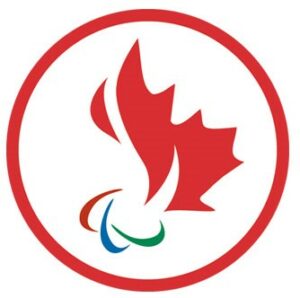 The uncertainty that’s been difficult to manage will continue throughout the Games, says Catherine Gosselin-Després, who is the Executive Director of Sport for the CPC. At Games time, Tokyo organizers are employing strict COVID‑19 guidelines to limit everybody’s movement. They’ll go to their events and then back to the Olympic Village. “We’ve been working with the national sport organizations trying to explain the environment. But obviously, none of us have lived this before.”
The uncertainty that’s been difficult to manage will continue throughout the Games, says Catherine Gosselin-Després, who is the Executive Director of Sport for the CPC. At Games time, Tokyo organizers are employing strict COVID‑19 guidelines to limit everybody’s movement. They’ll go to their events and then back to the Olympic Village. “We’ve been working with the national sport organizations trying to explain the environment. But obviously, none of us have lived this before.”
At the time of the interviews with fewer than 60 days to go to the Games, Canada’s Olympic and Paralympic planners usually know almost every detail right down to the size of the doorknobs for the 400 or so athletes who will be going for the Olympics and 130 athletes headed to the Paralympics. Typically, planners would have made many trips to the site to prepare for the Games. But that hasn’t been the case during the pandemic. With the Winter Games in Beijing kicking off just 6 months after the Summer Games in Tokyo, planners will cut and paste to try to reuse many of their Tokyo plans for Beijing.
Céline DesLauriers, Senior Manager of Games at the COC, says the master plan is 20 000 lines long. Her logistics team has gone from using Excel spreadsheets to an online software program where they can track changes on the fly. Instead of shipping the teams’ necessary sports gear and equipment, the way they have in the past, they’re chartering a cargo plane.
Another tricky part comes with travel arrangements. With the new COVID‑19 guidelines, athletes can only check into the Athletes’ Village up to 7 days before they compete. They must leave within 48 hours after their competition ends. For a team sport, that will require juggling for everyone involved when teams get eliminated.
“Normally, a couple of months out to the opening of the Village, the national sport organizations pretty much know who’s coming and everything. They’re just waiting for the final qualification. What we’re seeing is right now it’s being pushed till the very last seconds. We’re just learning to be nimble and adaptable,” DesLauriers says.
The priority: Health and safety
The COC and CPC aren’t releasing their usual performance benchmarks that normally proceed the Games. While they know most athletes will be aiming to get on the podium, they don’t want anybody feeling any added pressure. According to the CPC’s O’Neill, the overall well-being of Team Canada is the primary goal in Tokyo.
“What keeps me up at night, it’s my personal and professional commitment to the responsibility of ensuring that Team Canada is supported. The primary objective is that everyone is safe, healthy, both heading into Tokyo, during the Games and coming back afterwards.”
The COC’s Shoemaker says that includes keeping people in the host country safe as well. Until now, Japan has done a pretty good job of minimizing infections from the virus. With more than three times Canada’s population, Japan has had half our number of cases and deaths. And there are many COVID‑19 countermeasures to keep things that way during the Games. These include two negative tests prior to going, testing everybody daily upon arrival, and keeping everybody contained in the Village or at competition venues.

“Everyone should wipe clean from their minds what they think an opening ceremony or what a competition will look like. There will be no overseas spectators. There won’t be friends and family. We won’t have a Canada Olympic House in Tokyo. That doesn’t guarantee the complete safety but we’re doing our absolute best to prioritize the health of everybody involved,” Shoemaker says.
The CPC’s Gosselin-Després says many athletes have received their first vaccine and breathed a sigh of relief with the news in May that Pfizer would donate 2 doses for every athlete who wants to be vaccinated. “For us, that was key. I think the athletes would have probably had questions if there was just one dose. But now with the announcement, I think that’ll help everyone.” However, the Pfizer vaccine isn’t approved in all countries and there still could be positive COVID‑19 tests even among those who have been vaccinated.
Stephanie Dixon, who is a former Paralympic star athlete and now Chef de Mission for the CPC in Tokyo, says COVID‑19 just adds to the usual stress of performing at the Games. “I don’t think we can underestimate that level of stress,” Dixon says. “People are going to be nervous, if they feel a tickle in their throat. Every single one of us in the world has suddenly given new meaning to having a tickle in the throat or to a runny nose.”
The CPC and COC always plan for many different scenarios. For Tokyo, that includes a number of plans specifically for COVID‑19. For example, what to do if there’s a positive case? And what happens if there’s a false positive that forces somebody to miss their event? These are among the new questions they need to consider.
Finding new ways to communicate and connect
Every media story out of Japan has raised doubts about the Games and added to the uncertainty. It’s been hard to separate fact from fiction. That’s why a fundamental part of the CPC and COC plans for Tokyo and Beijing has become communicating and providing constant updates with the latest facts for all stakeholders. Since the fall, both committees have adopted a crisis communications approach.
In a crisis, communications experts say it’s important for leaders to clearly state what they know, what they don’t know, and when they hope to provide an update on what they don’t know. DesLauriers of the COC says, “That’s exactly the strategy we’ve taken in all of our communications.”
As Chef de Missions, Dixon and McBean have been meeting virtually every few weeks with athletes and other stakeholders. “This is the most engagement with athletes that I’ve ever seen prior to the Games,” says Dixon. “I think it’s important we’re getting them into a virtual, figurative room together because they can hear from each other what each has been going through. It helps us as a support staff really see into the minds of the athletes and see what they need from us.”
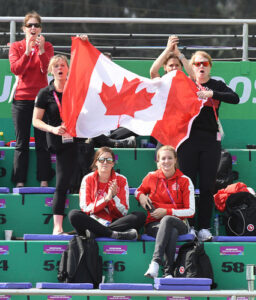
Before the pandemic, McBean expected to be travelling the country and providing a different kind of motivation. “Suddenly my interactions with the team and the conversations we were having with the athletes weren’t about this fun ambitious management to the podium. It was more life management.”
McBean advised the different teams and athletes that the fear and doubt they might be feeling are part of every athlete’s path. She told them not to worry about the big things. Focus on the little things that make you better and that’s when great things happen.
Dixon says at Games time, one of the issues they’re dealing with revolves around the team being told they must social distance when they aren’t competing. “One of the primary measures is to stay away from each other. If we can’t physically get close to one another, we can’t be cheering and singing. How do we get a sense of team unity?”
She says they’re looking for creative ways to connect the team. They’re thinking of having athletes post sticky notes with messages for one another, or doing virtual team recognition and medal ceremonies every day in Tokyo.
“At the end of the day, when athletes isolate after their events and go back to their rooms, we’re thinking about how we can break down those isolation walls in a virtual way.”
A focus on mental health
The prolonged sense of uncertainty added to the usual stress of the Games has created fertile ground for anxiety. It’s taking a toll on athletes as it has for the rest of society. Susan Cockle is a psychologist who is working with the CPC. She’ll be on site in Tokyo as the Mental Health Lead. It’s the first time the CPC has ever had one at the Games.

She says anxiety is actually the body and brain’s way of protecting us as humans. When things are uncertain, we go on high alert. “It’s like our emotional psychological furnace has been running on high for a while. When, our anxiety – our furnace – has been running on high, it doesn’t take much for it to break down,” says Cockle. “That’s why we need some ongoing service to the furnace, why we want to do some mental health mitigation. We want to do some prevention so that we can have that furnace run on a lower temperature, and not burn out.”
Normalizing the conversation and creating social support around mental health and wellness are 2 of the most important ways to do that. Shoemaker says it’s been a key focus for the COC too. “We have found it’s very important for us as we are delivering our team to two Games in six months to be very focused on how people are doing. I have found myself asking questions I would have never dreamt of asking a couple of years ago: ‘How are you doing and how are you feeling?’ and getting people to talk and open up.”
Cockle says checking in is important and recommends asking specific questions to help people focus their responses. “How are you doing with COVID‑19 is a big question. If you can make that question a little more contained, then people are more likely to answer more genuinely,” she says. “If you actually say, ‘how are you doing today’, you’re more likely to get an emotion. That’s what we want. We want those types of responses to be real and out in the open. Normalizing that can make people feel less alone.”
It’s not just the athletes who they’re concerned about for mental health, according to the COC’s DesLauriers. “It’s also for all the support staff and the mission team that will be on site. As an example, I’ll be in Tokyo 44 days. I’m not used to wearing a mask every day, having to do a test every day, doing the work that is normally pretty hard, amplified with all of the COVID‑19 countermeasures and restrictions that will be put on us.”
If things go sideways, both the COC and CPC have put plans in place with extra support, more reaching out and more points of contact. Athletes will know about extra resources from Game Plan or from the Canadian Centre for Mental Health and Sport.
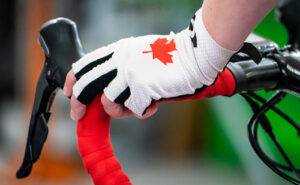
Cockle says mental performance consultants are also helping with mental health preparation. Penny Werthner is one of them. She’s assisting both the Olympic Athletics Team and the Paralympic Athletics Team among other athletes. Werthner always works with athletes and teams on distraction control and focus, emotional agility, dealing with disappointment and embracing chaos and uncertainty.
Werthner says COVID‑19 has added a few new areas. “There will presumably be distractions from people testing positive whether you’ve been vaccinated or not. That’s a whole added layer that we’ve never faced before.” Werthner says talking about it ahead of time helps athletes prepare if it does happen.
She says managing isolation is another new area. “In previous Olympics, athletes would have friends and family there. For many, that’s a comforting thing. They can actually escape the Olympics for a day or so.” But athletes won’t have that same luxury in Tokyo. “There’s presumably no escape. You’re not going to be able to go around the city in Tokyo and do something fun,” says Werthner.
That’s a concern for the CPC’s Dixon. “There’s so much stress and tension that builds up in the lead-up to the Olympics and Paralympics. Whether it is the performance you were looking for or not, you always need a release afterwards.” After years of preparation, Dixon worries many athletes may miss out on the vibe and hype that normally comes from connecting with teammates and performing in front of fans in the stands. That’s why she says the team needs to address mental health before, during and after the Games, and she is happy to see the support being offered. “We’ve never been so focused on mental health and wellness at the Games,” she says.
But despite the challenges of preparing for these atypical Olympic and Paralympic Games, Dixon believes the world will see strength, grit and determination of the human spirit in a way we’ve never witnessed before.
“We will see great performances brought and fueled from these great challenges and adversity. It’s incredible what we can accomplish when we’re given no choice.”
The Summer 2021 SIRCuit is now available!
The SIRCuit is designed to highlight important research and insights to advance the Canadian sport system. With the summer Olympic and Paralympic Games in Tokyo on the horizon and the winter Games in Beijing just around the corner, this edition of the SIRCuit dives into issues and trends that will be centre stage at (and after) the Games.
Highlights
- Sports fans and spectators, from the grassroots to the professional level, have had to engage with their favourite teams and athletes in new ways during the pandemic.
- Canadian sport businesses, broadcasters, leagues and teams are driving fan engagement through digital innovation, from virtual stadiums to streaming services.
- The introduction of new technologies, including advanced videoconferencing and streaming apps, helps to build virtual sport-centred communities, which is a key part of fan engagement.
- Sports organizations can, and should, create special moments for fans. For example, virtual meet-and-greets are great ways to connect fans with their favourite athletes and teams.
Sport, like all industries, adapted to the challenges of the ongoing COVID‑19 pandemic. Competitions and events were cancelled or they continued in empty stadiums. Over the past year, high-performance athletes have become used to long periods of isolation and competing on the world’s biggest stages without the roar of the crowd. At the same time, fans found new ways to engage, from home, with their favourite athletes and teams.
Following the announcement that no foreign spectators could enter Japan this summer for the Tokyo 2020 Olympic and Paralympic Games, the Games will be a unique spectacle. Having been postponed to 2021 due to the COVID‑19 pandemic, the Games present a challenge for Canadian sport organizations looking to build their fan base and raise their sport’s profile during the Games, despite the absence of foreign spectators.
Fortunately, Canadian sport organizations, broadcasters, leagues and teams have had nearly a year and a half to adapt to the ‘new normal’ of the pandemic. During this time, digital innovation has driven engagement and evolved the fan experience. Nonetheless, the fundamental principles of being a sports fan remain the same: It’s all about engaging with favourite athletes or teams, building a sports-centred community and experiencing special moments.
This article dives into the pandemic lessons and teachings of a Canadian sport broadcaster, professional sports and entertainment company, sport streaming business, and a professional league and team. Their stories offer strategies and examples to improve the viewing and engagement experience for any spectator.
Driving engagement through innovation
For Canadian sport organizations, businesses and broadcasters, the pandemic presented new opportunities alongside challenges. These opportunities led to new and more diverse audiences tuning into sports throughout the country. The driving force behind these opportunities? New technologies and digital innovation.
For example, as Team Canada’s official broadcast partner, CBC Sports adapted its coverage of a wide range of sports, from basketball to curling. This was largely facilitated by new technologies that Monika Platek, Senior Producer of Social Media at CBC Sports, likes to call “the shiny new things that we didn’t have a year ago.”

Over the past year, CBC Sports started to use Instagram Reels, short online videos that allowed Canadians to experience jaw-dropping moments or incredible athletic feats, and to reshare athlete-generated content. Another pandemic-spurred innovation was the introduction of StreamYard. As an easily accessible social broadcasting platform for podcasts and web shows, StreamYard allowed CBC Sports to produce sport-specific shows with contributors from across Canada. For example, figure skaters Dylan Moscovitch and Asher Hill hosted “That Figure Skating Show” on CBC’s YouTube channel throughout the winter. Additionally, Canadian curler and media personality Colleen Jones joined CBC journalist Devin Heroux to host “That Curling Show.” By highlighting underrepresented sports, CBC Sports received great feedback from the sports community, and reached new fan bases.
“StreamYard allowed us to break down geographical barriers and suddenly have all sorts of people in the same virtual space,” says Platek.
Like CBC Sports, many leagues, teams and companies across Canada have taken advantage of digital innovations to connect with fans and spectators. At the professional level, Maple Leaf Sports & Entertainment Ltd. (MLSE), owner of Toronto-based professional teams including the Toronto Maple Leafs and the Toronto Raptors, created the Digital Arena where fans could interact with each other and participate in online games. Similarly, the Canadian Premier League (CPL), a professional soccer league, developed an augmented reality “virtual stadium” during its 2020 season that enhanced the viewing experience for fans watching from home.
Duncan Fraser, Director of Event Experience at MLSE, says his team is “starting to use the term ‘hybrid’ a lot” when discussing post-pandemic plans. While everyone is eager to return to in-person sports and spectator experiences, there are some benefits of the virtual experience that will likely continue.
For instance, MLSE hosts workshops for local hockey and basketball coaches at the Maple Leafs’ and Raptors’ respective training facilities. During the pandemic, these clinics moved online. Instead of the usual 300 to 400 coaches in attendance, the online platform reached 2500 coaches from 43 countries worldwide. Although not fan specific, this experience showed MLSE that virtual platforms had the potential to expand the organization’s reach.
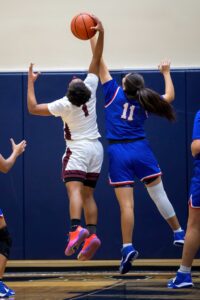
In 2020 and 2021, organizations have accelerated their implementation of streaming services for youth, amateur, and scholastic sports. GameOnStream is a Canadian company that provides state-of-the-art streaming technology for sports leagues and venues across North America. Using artificial intelligence (AI) technology to operate its camera systems instead of an in-person camera operator, GameOnStream’s services became increasingly popular during the pandemic.
“The pandemic has increased the speed of people realizing that if they don’t have streaming, that they should have it, and then figuring out how to do it,” says GameOnStream’s CEO Bob Wilkinson.
Wilkinson believes that “streaming has a positive impact on keeping people engaged in following and supporting sports, especially at the youth level.” These benefits can extend beyond spectators to analytics, teaching, game-tape reviews and evidence for in-game penalties.
From national sport broadcasters to independent streaming services, these examples show how new technology and digital innovation are driving fan engagement and virtual spectator experiences at all levels of sport, not only during the pandemic, but for years to come.
Building connections and a sense of community
While technology has kept the fan experience afloat during the pandemic, it’s only a part of the equation. At its core, being a sports fan is about building connections, either with a favourite team or athlete, or with other fans. The meaning and construction of these connections has changed significantly during a year defined by social distancing, quarantine and isolation. While quickly pivoting toward engaging fans virtually early in the pandemic, the sports sector’s big focus was on ensuring that connections were still being built and maintained. This required sport organizations to recognize some honest truths and get creative.
“As marketers, we asked: How can we create an at-home experience that makes it feel like you’re in the arena? We can’t. That’s the beauty of live sports,” says Fraser.

MLSE compensated for this reality with extensive innovation. In spring 2021, MLSE launched the Digital Arena to introduce elements of a live venue to fans at home. While watching a Maple Leafs or Raptors game on their televisions, fans could access Digital Arena through a smartphone app. This app facilitated fan engagement by using tools like trivia competitions, chatrooms and 50/50 draws. As a result, fans connected with their favourite teams, as well as with each other, and built a sense of community.
National Hockey League (NHL) and National Basketball Association (NBA) games were also able to reach millions of fans consistently through broadcasting partners such as TSN, CBC and Sportsnet. In fact, Canadian hockey viewership during the pandemic has increased substantially relative to past years.
While MLSE took strides to promote fan engagement during games, it also realized that most fan experience occurs outside game time. “A year ago, a live experience event group facing a pandemic is not necessarily exciting, but we’ve created a ton of amazing at-home experiences for our fans that have been elevated throughout the entire year,” says Fraser.
MLSE’s event experience team has planned hundreds of events ranging from intimate Zoom calls with Maple Leafs legends to cooking lessons with MLSE’s chefs to sending game-day pucks to lucky season-ticket holders. These wide-ranging and creative ideas allowed fans of all sorts to get excited and stay connected with their favourite teams. MLSE effectively coupled its game-time experiences, such as Digital Arena, with non-game-time experiences, like virtual meet-and-greets that continually engage teams’ fan bases.
That said, MLSE was fortunate to have entered the pandemic with ample resources and large, long-standing fan bases for their teams. Meanwhile, lesser-known sports and leagues had to find ways to build connections with new fans and use more limited resources to reach out to their followers.
For example, Canadian soccer has persisted as a fan-centred sport with devoted supporters’ groups and dedicated followings throughout the pandemic. Nowhere is this clearer than in Nova Scotia, home of the Halifax Wanderers Football Club (HFX Wanderers). Despite HFX Wanderers being a brand-new team in the Canadian Premier League, its supporters banded together to form a vibrant and inclusive community whose influence extends beyond the sport.

The club’s #TogetherFromAways motto exemplifies the strength of the team’s community in the face of challenge. HFX Wanderers Marketing and Brand Manager, Dylan Lawrence says, “In Halifax, we don’t have these larger NHL or NBA franchises. I think there’s a lot of people in this community that needed a platform like the Wanderers to showcase that love for each other and the support of the game.”
Lawrence also describes the pandemic as “a blessing in disguise … it was good for us to have an opportunity without soccer being the prime focus to understand the market a bit better.” This helped the club find new ways to interact with its fans and establish its presence within the Halifax community. For instance, HFX Wanderers players participated in vaccination initiatives and developed relationships with local youth soccer clubs. Fans responded in kind. An example is superfan Missy Searl, widely known as “Mama Searl.” She cooked and delivered personalized meals to HFX players during Nova Scotia’s most recent lockdown. Throughout the pandemic, HFX Wanderers and fans formed new connections and deepened pre-existing ones.
MLSE and HFX Wanderers represent opposite ends of the professional sports spectrum in Canada. One owns some of Canada’s most recognizable sports franchises, while the other is building itself from the ground up as part of a new league. However, both recognized the importance of connecting with fans during the pandemic by continuing to build their respective sports-centred communities.
Creating special moments
The pandemic provided sports with opportunities to engage new audiences and experiment with state-of-the-art technologies. But the most exciting part of being a sports fan remains the same: the special, edge-of-your-seat moments. These are what make sports memorable.
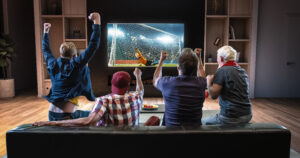
Fortunately, you don’t have to be there in person to experience the excitement. Millions of Canadians celebrated Sidney Crosby’s 2010 golden goal at home with family and friends. Entire households cheered from their couches as Penny Oleksiak stormed back to claim gold in the 100m freestyle in Rio de Janeiro. Fans right across the country celebrated the Toronto Raptors’ 2019 championship run. Despite the challenging circumstances of the pandemic, moments such as those haven’t disappeared. Fans can experience them from home, and the pandemic has even made these moments more accessible to all Canadians.
“At the onset [of the pandemic], we were always looking for what is the biggest and best idea. How are we going to get thousands of people to all watch the game together?” says MLSE’s Fraser. This turned out to be a trap. As MLSE quickly realized, driving fan engagement is often less about the size of the crowd and more about the quality of the experience.
“People are tired of screens. Unless that moment is really special, or feels individual to that person, it’s just not going to be worth it,” says Fraser.
This prompted MLSE to implement smaller virtual meet-and-greets and personalized experiences that created special moments for both fans and athletes. Whereas in-person meet-and-greets can sometimes be awkward for professional athletes, Fraser says the players had outstanding feedback for this year’s virtual events: “They were funny and engaging…. The players didn’t stop talking. They loved sharing stories.”
Interestingly, the pandemic has prompted a new hunger for ‘special moments’ at the grassroots level, as well. With family members often unable to attend their children’s practices and competitions because of capacity limits and social distancing requirements, streaming technology has played a key role in bringing youth and scholastic sport events to family, friends and classmates.
Parents who can’t make it to a game can still watch their kids. And students can cheer on their school’s team from afar. “You can watch the game from the parking lot on your phone or on your tablet at home… all the games are live and on demand there,” says GameOnStream’s Wilkinson.
Elderly individuals, who have been especially isolated during the pandemic because of health concerns, can also watch their grandchildren on the field, court or ice, from their computers.
“You get some of the most amazing letters and notes from grandparents being able to watch their grandchildren,” says Wilkinson.
There may be fewer people in the stands seeing a special highlight-reel goal, but there are many more people watching from behind a screen.
Toward a ‘new normal’ for fan engagement

With Tokyo 2020 on the horizon and Beijing 2022 just around the corner, the lessons for fan engagement learned during the pandemic are already being put into practice. CBC Sports extended its use of the StreamYard platform to cover Swimming Canada’s Olympic trials as well as late June’s final Olympic qualification tournament for Canada’s men’s basketball team. In addition, a virtual watch-party featuring guests and commentators is planned for Tokyo 2020’s opening ceremony, on July 23. And while a small media delegation will travel to Japan this summer, most of the Olympic and Paralympic coverage will originate in Canada.
“We are in really good shape to take on the Games from this sort of virtual space, because we’ve been doing it now for 16 months. We have really innovated and changed a lot in the last year, and I think we’re really prepared to take on these games from our at-home offices,” says CBC Sports’ Platek.
Through tough times, sports have proven to be a uniting factor for fans around the world. In the face of immense challenge, Canadian sport businesses and organizations have adopted several innovative strategies to engage their fans virtually and strengthen sports-centered communities. From intimate Zoom calls with athletes to new sports-specific programming, digital innovation continues to thrive and connect fans with each other and the special moments that sport offers. All the while, the sports community continues to grow.
As HFX Wanderers’ Lawrence remarks, this year for sports fans has been about “recognizing that we all wander individually, but it’s when we wander together that life is how it should be.”
Highlights
- In recent years, national sport organizations have been hard at work on Safe Sport policies and initiatives. They’re designed to ensure the safety and well-being of sport communities, from the grassroots level all the way up to national teams.
- Sport organizations have several opportunities to advance Safe Sport, including:
- Revising existing policies to ensure consistency with new policy documents
- Working on initiatives with experts in the field, such as researchers and lawyers
- Making sure key stakeholders are aware of policy changes, why they’re happening, and the available resources
- Finding unique and engaging ways to promote Safe Sport policies, initiatives, tools and resources may help sport organizations to reach their intended audiences. Those promotions may also make the Safe Sport message stick.
Perhaps not surprisingly, the unofficial theme of the Tokyo 2020 Olympic and Paralympic Games has been ‘safety first.’ Postponed from 2020 to 2021 due to the COVID‑19 pandemic, the Summer Olympic and Paralympic Summer Games are scheduled to take place respectively from July 23 to August 8 and from August 24 to September 5.
Even before the word COVID‑19 entered our global vocabulary, safety was top of mind for national sport organizations (NSOs). In the years leading up to the pandemic, more and more high-profile abuse and maltreatment cases in sport had made national and international headlines. From these revelations, the Safe Sport movement was born.
The words safe and safety often make us think of preventing physical injury or harm. But the Safe Sport movement is about more than that. It’s about optimizing the sport experience for everyone involved in sport. Safe Sport involves the reasonable expectation that the sport environment will be free from all forms of maltreatment (that is, abuse, neglect, bullying, harassment and discrimination) and that it will also be accessible, safe, welcoming and inclusive.
A prime example of how Safe Sport has advanced in recent years is the Universal Code of Conduct to Prevent and Address Maltreatment in Sport (UCCMS) coming into being. Officially released in 2019, the UCCMS encourages a Safe Sport environment by providing NSOs with guiding principles, defining prohibited behaviours and outlining sanctions for misconduct.
With both the Tokyo and Beijing Olympic and Paralympic Games set to take place over the next several months, NSOs have been hard at work on Safe Sport policies and initiatives. NSOs want to ensure the safety and well-being of their sport communities, from the grassroots level all the way up to their national teams. In this article, we take a deep dive into how 4 NSOs (Alpine Canada, Gymnastics Canada, Hockey Canada and Softball Canada) are advancing Safe Sport. We also discuss tips, strategies and lessons learned for other sport organizations working to optimize the sport experience for everyone.
Building and strengthening Safe Sport policies
For all 4 NSOs we interviewed, advancing Safe Sport meant first addressing policy to protect their sport communities, including athletes, coaches, staff and others involved in the sport environment. For example, after the UCCMS was established, each sport went straight to modifying their existing bullying and harassment policies.
“The Safe Sport movement has allowed us to re-address some of those areas, and certainly start to build and strengthen them as we move forward,” says Todd Jackson, Director, Insurance and Risk Management at Hockey Canada.
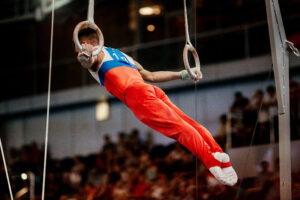
The idea of Safe Sport as a “movement” was echoed by other NSOs. They viewed the UCCMS as more than just a document to integrate into their existing policies, but rather the driving force behind a cultural shift in the way we see, think, and speak about maltreatment in sport. That shift has begun to take hold, but it requires continued action.
“While updating our organizational policies has been an important step for enhancing safety, there is still much work to do in education and advocacy to bring them to life in practice,” says Ellen MacPherson, Director, Safe Sport at Gymnastics Canada.
Part of that shift is to consider the language we use to describe and discuss Safe Sport. For instance, the use of terms like maltreatment have been adopted to discuss abuse and harassment in sport. According to Kristin Noonan, Manager, Coaching & Safe Sport at Softball Canada, consistent terminology was an important part of Softball Canada’s first step toward revising their policies and developing Safe Sport initiatives.
“With the release of the UCCMS, we wanted to ensure the terminology used within was consistent with the terminology on our website, within our own policies and in all of our Safe Sport initiatives,” says Noonan.
Having a shared understanding of key terminology and being consistent in its use is an important step for any organization, club or team when making changes and advancing toward a “new normal” or culture. Something as simple as creating a glossary can help make sure everyone is on the same page.
Another strategy is to seek out and lean on experts in the field. As part of their efforts to refresh policies, the NSOs we interviewed touched on the importance of consulting with experts in the field, including researchers and lawyers.
“I think anytime that you’re integrating new guidelines like that, to have the experts around you and have people who can give you input on what you’re doing and not doing is a real benefit and helps to alleviate some of those challenges,” says Jackson.
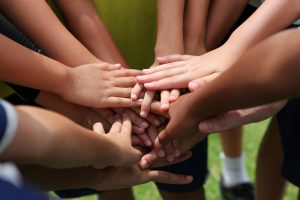 For example, Gymnastics Canada developed a new policy, dubbed the “Diversity, Equity and Inclusion Policy,” in collaboration with researchers and experts within and outside of the sport. In addition to that policy’s launch, Gymnastics Canada is currently creating supplemental eLearning resources that highlight key aspects of the policy and can be shared by the broader sport community. According to MacPherson, “The Diversity, Equity and Inclusion Policy is a foundational policy from which further initiatives designed to enhance diversity, equity and inclusion in Canadian gymnastics can be built.” It was put in place to ensure all participants feel welcome, respected and have equitable opportunities to experience the physical and mental health benefits of sport participation.
For example, Gymnastics Canada developed a new policy, dubbed the “Diversity, Equity and Inclusion Policy,” in collaboration with researchers and experts within and outside of the sport. In addition to that policy’s launch, Gymnastics Canada is currently creating supplemental eLearning resources that highlight key aspects of the policy and can be shared by the broader sport community. According to MacPherson, “The Diversity, Equity and Inclusion Policy is a foundational policy from which further initiatives designed to enhance diversity, equity and inclusion in Canadian gymnastics can be built.” It was put in place to ensure all participants feel welcome, respected and have equitable opportunities to experience the physical and mental health benefits of sport participation.
Finally, NSOs are increasingly turning to independent third parties to resolve violations of Safe Sport policy. For instance, Alpine Canada formed the Alpine Independent Supervisory Board: A group of professionals including lawyers, researchers and other independent investigators who are external to the organization and solely responsible for the adjudication of major infractions. In addition, the Government of Canada recently announced that the Sport Dispute Resolution Centre of Canada has been selected to establish and deliver a new Independent Safe Sport Mechanism that will oversee the implementation of the UCCMS for federally funded sport organizations. Establishing a third party to specifically handle violation cases not only helps to strengthen policy, but also allows for a neutral adjudication process that minimizes bias and conflicts of interest.
However, according to Joseph Gurgis, who recently left the role of Safe Sport Manager at Alpine Canada to pursue a Postdoctoral Fellowship at Cape Breton University, Safe Sport is about more than policy. “A multifaceted approach that extends beyond policy implementation to include education, advocacy, independent complaint mechanisms, research, monitoring, and evaluation is required to ensure that we adequately advance a culture of Safe Sport,” he says.
This leads us to another cornerstone of Safe Sport: education.
From the ground up: Education and awareness
What is maltreatment? What does maltreatment look like? And what is Safe Sport? Gurgis reflected on this new terminology and how an important part of Safe Sport is making sure people know what it is.
“There’s a lot of behaviours in sport that are harmful but normalized by stakeholders, who are often unaware of how certain sport practices may be harmful to a person’s physical or psychological welfare,” says Gurgis.
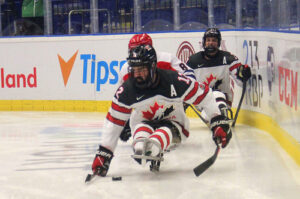
Ironically, when discussing Safe Sport with those who are meant to benefit from it, few can articulate what Safe Sport is and what it’s meant to achieve. For Jackson and Hockey Canada, it all boils down to 2 words: education and awareness.
“I think that’s where the education and awareness become so important, because you not only have to put a policy in front of an organization or put a policy in front of people, you have to explain why you’re putting that policy in front of them. And you also have to give them a little bit of background on how to work within that policy,” says Jackson.
Jackson highlighted the Speak Out! program as a foundational component of Hockey Canada’s approach to Safe Sport. Speak Out! Was originally created in 1997 to educate and prevent bullying, harassment and abuse in hockey across Canada. Hockey Canada established the Speak Out! Subcommittee to oversee the building of the Speak Out! program as it progressed.
“[The Subcommittee] put together a framework for the program that included policy building, education at our grassroots levels, screening, which continues at all levels of the game, and creating awareness around the prevention of bullying, harassment, and abuse,” says Jackson. “It continues to be delivered by our members in various forms, to our volunteers, to our coaches, to the people involved with young players across the country.”
More recently, NSOs across Canada have focused their efforts on creating effective and engaging educational tools focused on maltreatment and Safe Sport more generally, especially before sending their best athletes off to Tokyo. This includes increasing awareness of practices that may be harmful or problematic, as well as resources that are available to participants for reporting and assistance. As part of this process, many NSOs are requiring mandatory screening in addition to Safe Sport training for all Olympic- and Paralympic-bound participants. This screening is now also being carried out at lower-level sports organizations.
 The NSOs we interviewed also described unique initiatives to educate and engage their communities from the ground up. For example, Gymnastics Canada has launched a new Safe Sport Learning Series and a Safe Sport Champions Series this summer. Designed to complement one another, these series leverage research experts and mentors in the field of Safe Sport. They’ll share insights and practical tips for creating healthy, safe and positive environments for participants at the grassroots level all the way up to Gymnastics Canada’s national and high-performance teams.
The NSOs we interviewed also described unique initiatives to educate and engage their communities from the ground up. For example, Gymnastics Canada has launched a new Safe Sport Learning Series and a Safe Sport Champions Series this summer. Designed to complement one another, these series leverage research experts and mentors in the field of Safe Sport. They’ll share insights and practical tips for creating healthy, safe and positive environments for participants at the grassroots level all the way up to Gymnastics Canada’s national and high-performance teams.
“We’re building on this [Safe Sport] momentum in the lead up to Tokyo by continuing IST (Integrated Support Team), as well as inviting experts and mentors to deliver webinars and workshops for the national team and high-performance community. Topics will include positive coaching practices, enhancing mental health, self-awareness, building resilience and staying positive, and supporting nutrition and healthy eating,” says Gymnastics Canada’s MacPherson.
At Softball Canada, Safe Sport Onboarding is the newest educational initiative. The Safe Sport Onboarding program is designed to educate, protect and empower all members of Softball Canada. And the program has already been mandated for players, coaches and support staff heading to Tokyo for the Olympic Games.
“Leading up to the Olympics, we are providing a Safe Sport education package to the team and we will also be giving a Safe Sport presentation specifically for our Women’s National Team Program prior to their departure for the Games,” says Noonan.
This initiative will educate Softball Canada’s participants on the reporting processes, policies, guidelines and contacts related to Safe Sport at the Games. Understanding that individuals won’t necessarily read through all policy documents, Noonan spoke to the importance of this education program as a way of providing key stakeholders with the main pieces of information in a more digestible and engaging way.
Thinking outside the box (and other advice for sport organizations)
While policies and educational initiatives are important, they need to be developed and delivered in a way that resonates with intended audiences. The NSOs we interviewed stressed the importance of getting creative with educational tools and policy resources. That creativity is essential not only for promoting key messages, but perhaps more importantly, for making Safe Sport messages stick.
“It’s got to be delivered in a way that’s user friendly, and at the same time effective. Engagement is so important so that people will be responsive and so [the Safe Sport movement] will continue to grow,” says Hockey Canada’s Jackson.
 To reach provincial/territorial sport organizations (PTSOs) and grassroots clubs in each sport, some NSOs have come up with innovative strategies to increase uptake. Softball Canada offers a great example. It shares its policy templates and resources, including access to lawyers, with softball PTSOs. Doing so limits the work needed by PTSOs to adjust their policy suite, meaning that implementation is quicker and more consistent across all levels of sport.
To reach provincial/territorial sport organizations (PTSOs) and grassroots clubs in each sport, some NSOs have come up with innovative strategies to increase uptake. Softball Canada offers a great example. It shares its policy templates and resources, including access to lawyers, with softball PTSOs. Doing so limits the work needed by PTSOs to adjust their policy suite, meaning that implementation is quicker and more consistent across all levels of sport.
“The UCCMS became a backbone for us moving forward with our provincial/territorial alignment, allowing us to take our complete policy manual and provide templates to each of the [PTSOs],” says Noonan.
Her most important tip for sport organizations that are working to build up their Safe Sport initiatives is to think outside the box. “[Think about] what can be done in addition to those policies and procedures. Make it fun and provide awareness by getting it out there in different ways than just on a piece of paper,” Noonan says.
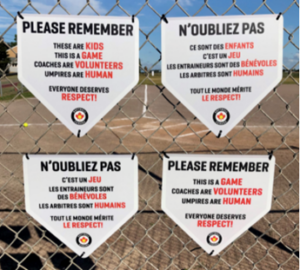
For example, Softball Canada has created a short video to educate stakeholders about Safe Sport. It has also developed postcards and backstop signs that reinforce key Safe Sport messages for spectators, including parents and guardians, at youth and adult softball events.
“They [the signs] hang on the backstop so that all the fans and parents can see them. A gentle reminder for all involved that everybody deserves respect,” says Noonan. “Fun, outside-the-box ideas are what has made our initiatives so successful because they’re simple and tangible. It’s more than just reading a policy.”
In addition to getting the message out in an engaging way, it’s important to ensure that the voices of stakeholders are included in decisions about Safe Sport policy and initiatives. At Gymnastics Canada, that involves hearing input from voices within the gymnastics community. Hearing from people who are experiencing or implementing Safe Sport principles was important for figuring out if there were any gaps, resolving any, and thinking about ideas for future development.
“Safe Sport is an ever-evolving portfolio. It’s important to work collaboratively with our stakeholders and incorporate their input to ensure the safety, health, well-being and inclusiveness of all participants,” says MacPherson.
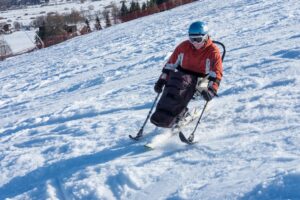 For its part, Alpine Canada established a National Safe Sport Committee comprised of 25 individuals, including parents, athletes, coaches and sport administrators, from across Canada’s skiing community. “The advancement of Safe Sport requires the collective efforts of all stakeholders in sport. So, the purpose of this diverse collaboration is to engage participants, from each stakeholder organization, in meaningful conversations regarding Safe Sport and to provide them a platform to openly discuss their Safe Sport needs,” says Gurgis. This committee gathers 4 times per year to discuss key Safe Sport concepts, establish and discuss Safe Sport goals, identify stakeholder responsibilities for advancing Safe Sport in the community, clarify ways to monitor and advance Safe Sport, and evaluate Alpine Canada’s Safe Sport progress overall to provide recommendations for next steps.
For its part, Alpine Canada established a National Safe Sport Committee comprised of 25 individuals, including parents, athletes, coaches and sport administrators, from across Canada’s skiing community. “The advancement of Safe Sport requires the collective efforts of all stakeholders in sport. So, the purpose of this diverse collaboration is to engage participants, from each stakeholder organization, in meaningful conversations regarding Safe Sport and to provide them a platform to openly discuss their Safe Sport needs,” says Gurgis. This committee gathers 4 times per year to discuss key Safe Sport concepts, establish and discuss Safe Sport goals, identify stakeholder responsibilities for advancing Safe Sport in the community, clarify ways to monitor and advance Safe Sport, and evaluate Alpine Canada’s Safe Sport progress overall to provide recommendations for next steps.
Moving toward Safe Sport in Canada
As shown, sport organizations across Canada have taken various steps to advance the Safe Sport movement. Safe Sport, and the UCCMS specifically, are direct in what is “unacceptable” behaviour in sport. However, there’s a growing need to prepare organizations and participants with information about “acceptable” behaviours and best practices.

“Often we say, ‘Don’t do this’ or ‘Don’t do that’ but we rarely say, ‘What does that Safe Sport environment look like?’ and ‘How do we make it safe and welcoming? It really is about following those True Sport principles and reminding everyone what a supportive environment looks like,” says Softball Canada’s Noonan.
Similarly, Gurgis encourages sport organizations to think about Safe Sport beyond the conceptualization of preventing maltreatment.
“At Alpine Canada, it represents so much more. Safe Sport isn’t just about eliminating maltreatment, but it’s also about optimizing the sport experience to ensure that everyone understands their fundamental right to participate in and access a version of sport that embraces values such as respect, inclusion, and fair play,” says Gurgis.
It appears that Safe Sport is more than just a phase, but rather the “new normal” for sport. There’s still much to learn and do to create Safe Sport spaces across Canada, but Alpine Canada, Gymnastics Canada, Hockey Canada and Softball Canada have demonstrated important lessons and learnings to protect the safety and well-being of all participants. For other NSOs looking to advance Safe Sport within their sport communities, key learnings include:
- No need to reinvent the wheel. Start with your existing policies and modify them to be consistent with policy documents like the UCCMS. This might include updating language and terminology. Make sure these policies and resources are also reaching PTSOs and community sport organizations.
- Call on the experts. Consider including researchers and lawyers who can provide their expertise and input on Safe Sport policies and initiatives.
- Education is key. It’s important that all participants are aware of the resources that have been created for them. They should also be educated about how to use new policies, procedures, tools and resources (for example, how to report instances of misconduct).
- Be creative! Find unique ways to promote Safe Sport policies, initiatives, tools and resources in ways that are engaging and will stick with members of your sport community.
- Get connected. Consider establishing groups or networks that connect representative members of your sport community to discuss Safe Sport and related initiatives. Learn what works and what doesn’t for different members.
Employing these tips and strategies can help sports to build, strengthen, educate and grow awareness of Safe Sport. Join the movement to optimize sport experiences for all!
Recommended resources
Additional information, the Universal Code of Conduct to Address Maltreatment in Sport (UCCMS) and resources on safe sport in Canada can be found on SIRC’s website: https://sirc.ca/safesport
The upcoming Tokyo Games will provide a platform for Canadian athletes to shine. For many, their development path has not been a straight line from playground to podium. Learn about RBC Training Ground and Paralympian Search – two programs designed to support athlete development in Canada and help build the pipeline of future podium hopefuls.
In a survey of national team athletes led by Game Plan in 2020, 34% of respondents said the postponement of the Tokyo Games changed their retirement plan from sport. Some said they would have to retire earlier than planned, while others chose to push their retirement for another year.
The master project plan for an event like the Summer Olympic or Paralympic Games is approximately 20,000 lines long. The postponement of the Tokyo Games has provided the Canadian Olympic Committee and Canadian Paralympic Committee the opportunity to review, evaluate, and refine their policies and practices. These enhancements will ultimately benefit Canadian athletes and their performance.
